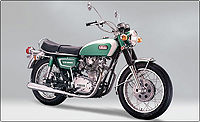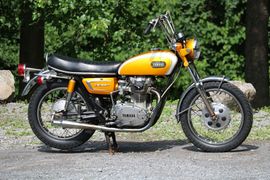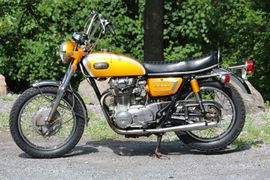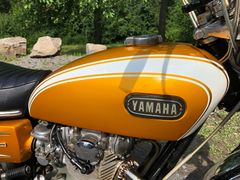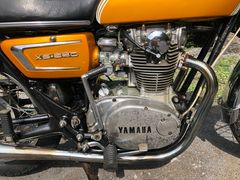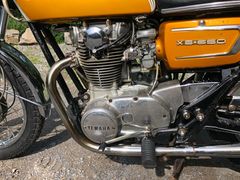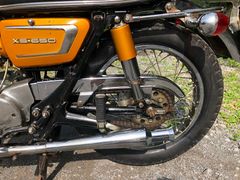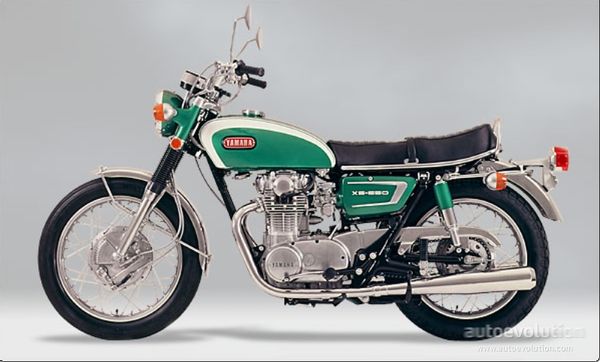Difference between revisions of "Yamaha XS1"
(adding class) |
|||
| Line 1: | Line 1: | ||
{{DISPLAYTITLE:{{PAGENAME}}: review, history, specs}} | {{DISPLAYTITLE:{{PAGENAME}}: review, history, specs}} | ||
{{Motorcycle | {{Motorcycle | ||
|name = '''Yamaha XS-1''' | |name = '''Yamaha XS-1''' | ||
| | |photo = 1970 Yamaha XS-1.jpg | ||
|aka = | |aka = | ||
|manufacturer = [[Yamaha]] | |manufacturer = [[Yamaha]] | ||
| Line 64: | Line 9: | ||
|model_year = | |model_year = | ||
|predecessor = | |predecessor = | ||
|successor = | |successor = [[Yamaha XS650]] | ||
|class = [[ | |class = [[Standard]] | ||
|engine = Air Cooled, Four Stroke, Parallel Twin Cylinder, SOHC, 2 Valves Per Cylinder | |engine = Air Cooled, Four Stroke, Parallel Twin Cylinder, SOHC, 2 Valves Per Cylinder | ||
|bore_stroke = 73.7mm x 73.7mm | |bore_stroke = 73.7mm x 73.7mm | ||
| Line 99: | Line 44: | ||
|competition = | |competition = | ||
}} | }} | ||
[[Image:1970 Yamaha XS-1 green white.jpg|200px|thumb|left|1970 Yamaha XS-1 green white]] | |||
The 1970 '''XS-1''' was the first [[Yamaha]] [[4-stroke]] model featuring a 650cc vertical, twin cylinder [[engine]]. It became extremely popular due to its reliability and high level of rider enjoyment. | |||
This took them firmly into Triumph and Honda territory with a 653cc vertical twin, overhead- | |||
camshaft model using knowledge they had gained from [[Hosk]], a firm that came to them with | |||
[[Showa]]. Whereas the latter had introduced them to two-stroke engines with disc valves, the Hosk line included a 500cc ohc twin which was capable of 110mph and well able to run with some of the best from Britain . | |||
The XS1 was not as quick as the Hosk and lacked its character but was a more civilized | |||
machine. It led on to the [[Yamaha XS2|XS2]] of 1972, when it was joined by two short-lived models. The first of these was the [[Yamaha TX750|TX750]], a vertical twin which introduced balance shafts within the crankcase to reduce vibration. The system was known as 'Omni-Phase Balancer' and worked well, but the machine proved unreliable and was quickly dropped. The second model, which never reached production, had a 662cc rotary Yanmar twin engine and was only seen at Tokyo shows. In 1973 the [[Yamaha TX500|TX500]] appeared with twin overhead camshafts and two years later evolved into the [[Yamaha XS500|XS500]] which sold to the end of the decade, but never in large numbers. | |||
The '''[[Yamaha]] XS-1''' was a Air Cooled, Four Stroke, Parallel Twin Cylinder, SOHC, 2 Valves Per Cylinder Naked [[motorcycle]] produced by [[Yamaha]] in 1970. Max [[torque]] was 39.83 ft/lbs (54.0 Nm) @ 6800 RPM. Claimed [[horsepower]] was 52.97 HP (39.5 KW) @ 7200 RPM. | The '''[[Yamaha]] XS-1''' was a Air Cooled, Four Stroke, Parallel Twin Cylinder, SOHC, 2 Valves Per Cylinder Naked [[motorcycle]] produced by [[Yamaha]] in 1970. Max [[torque]] was 39.83 ft/lbs (54.0 Nm) @ 6800 RPM. Claimed [[horsepower]] was 52.97 HP (39.5 KW) @ 7200 RPM. | ||
| Line 110: | Line 67: | ||
==Chassis== | ==Chassis== | ||
It came with a 3.50-19 front [[tire]] and a 4.00-18 rear tire. Stopping was achieved via Drum in the front and a Drum in the rear. The front suspension was a Telescopic Forks while the rear was equipped with a Dual Shock Absorbers. | It came with a 3.50-19 front [[tire]] and a 4.00-18 rear tire. Stopping was achieved via Drum in the front and a Drum in the rear. The front suspension was a Telescopic Forks while the rear was equipped with a Dual Shock Absorbers. | ||
==1971== | |||
<gallery mode='packed-hover'> | |||
File:1971-yamaha-xs1-b-0.jpg|1971 YAMAHA XS1-B | |||
File:1971-yamaha-xs1-b-1.jpg|1971 YAMAHA XS1-B | |||
File:1971-yamaha-xs1-b-2.jpg|1971 YAMAHA XS1-B | |||
File:1971-yamaha-xs1-b-3.jpg|1971 YAMAHA XS1-B | |||
File:1971-yamaha-xs1-b-4.jpg|1971 YAMAHA XS1-B | |||
File:1971-yamaha-xs1-b-5.jpg|1971 YAMAHA XS1-B | |||
</gallery> | |||
==1970 - 1980 Yamaha XS-1== | ==1970 - 1980 Yamaha XS-1== | ||
| Line 117: | Line 84: | ||
[[Category: | |||
{{Yamaha}} | |||
[[Category:Yamaha motorcycles]] | |||
[[Category:Yamaha XS series]] | |||
[[Category:Yamaha motorcycles]] | [[Category:Yamaha motorcycles]] | ||
[[Category:1970s motorcycles]] | [[Category:1970s motorcycles]] | ||
Revision as of 16:49, 29 August 2019
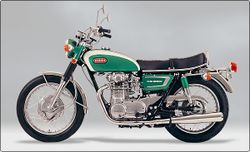 |
|
| 'Yamaha XS-1' | |
| Manufacturer | [[Yamaha]] |
|---|---|
| Production | 1970 |
| Class | [[:Category:Standard motorcycles|Standard]] [[Category:Standard motorcycles]] |
| Successor | Yamaha XS650 |
| Engine | Air Cooled, Four Stroke, Parallel Twin Cylinder, SOHC, 2 Valves Per Cylinder |
| Bore / Stroke | 73.7mm x 73.7mm |
| Compression ratio | 8.4:1 |
| Horsepower | 52.97 HP (39.5 KW) @ 7200RPM |
| Torque | 39.83 ft/lbs (54.0 Nm) @ 6800RPM |
| Transmission | Gear box: 5 Speed Final Drive: Chain |
| Suspension | Front: Telescopic Forks Rear: Dual Shock Absorbers |
| Brakes | Front: Drum Rear: Drum |
| Front Tire | 3.50-19 |
| Rear Tire | 4.00-18 |
| Weight | |
| Manuals | Service Manual |
The 1970 XS-1 was the first Yamaha 4-stroke model featuring a 650cc vertical, twin cylinder engine. It became extremely popular due to its reliability and high level of rider enjoyment. This took them firmly into Triumph and Honda territory with a 653cc vertical twin, overhead- camshaft model using knowledge they had gained from Hosk, a firm that came to them with Showa. Whereas the latter had introduced them to two-stroke engines with disc valves, the Hosk line included a 500cc ohc twin which was capable of 110mph and well able to run with some of the best from Britain .
The XS1 was not as quick as the Hosk and lacked its character but was a more civilized machine. It led on to the XS2 of 1972, when it was joined by two short-lived models. The first of these was the TX750, a vertical twin which introduced balance shafts within the crankcase to reduce vibration. The system was known as 'Omni-Phase Balancer' and worked well, but the machine proved unreliable and was quickly dropped. The second model, which never reached production, had a 662cc rotary Yanmar twin engine and was only seen at Tokyo shows. In 1973 the TX500 appeared with twin overhead camshafts and two years later evolved into the XS500 which sold to the end of the decade, but never in large numbers.
The Yamaha XS-1 was a Air Cooled, Four Stroke, Parallel Twin Cylinder, SOHC, 2 Valves Per Cylinder Naked motorcycle produced by Yamaha in 1970. Max torque was 39.83 ft/lbs (54.0 Nm) @ 6800 RPM. Claimed horsepower was 52.97 HP (39.5 KW) @ 7200 RPM.
Engine
A 73.7mm bore x 73.7mm stroke result in a displacement of just 343.0 cubic centimeters.
Drive
The bike has a 5 Speed transmission.
Chassis
It came with a 3.50-19 front tire and a 4.00-18 rear tire. Stopping was achieved via Drum in the front and a Drum in the rear. The front suspension was a Telescopic Forks while the rear was equipped with a Dual Shock Absorbers.
1971
1970 - 1980 Yamaha XS-1
The Yamaha XS 650 was produced from 1970 to 1980 and in the US the last model appeared in 1984. The first model was named XS-1, followed by XS-1B in 1971, XS-1 in 1972.
| ||||||||
